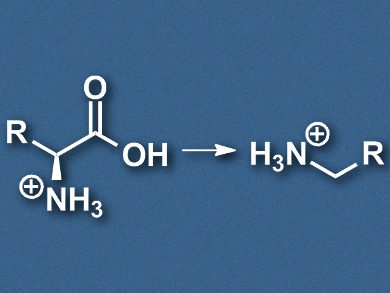Amino acids are renewable resources for the production of bio-based chemicals. Amines are important reactants in organic chemistry and can be used in the production of, e.g., pharmaceuticals, materials, and surfactants. Existing processes to prepare amines often use high temperatures or give mixtures of products.
Dirk E. De Vos and colleagues, University of Leuven, Belgium, have developed a ruthenium-catalyzed reaction that converts amino acids into primary amines in water (reaction pictured). The team used a Ru/C catalyst with a high surface area, H2 as a reduction agent, and H3PO4 to control the pH of the solution. L-Valine, for example, was converted into isobutylamine with yields of up to 87 %.
The reaction proceeds via hydrogenation of the amino acid to an α-amino alcohol, which loses CO to form the corresponding amine. The CO is, in turn, hydrogenated to give methane, which can be recycled. Reaction temperatures can be as low as 135 °C. According to the researchers, the sustainable process is applicable for the synthesis of a variety of primary amines.
- Ru-Catalyzed Hydrogenation–Decarbonylation of Amino Acids to Bio-based Primary Amines,
Jasper Verduyckt, Robin Coeck, Dirk E. De Vos,
ACS Sustainable Chem. Eng. 2017.
DOI: 10.1021/acssuschemeng.6b03140




